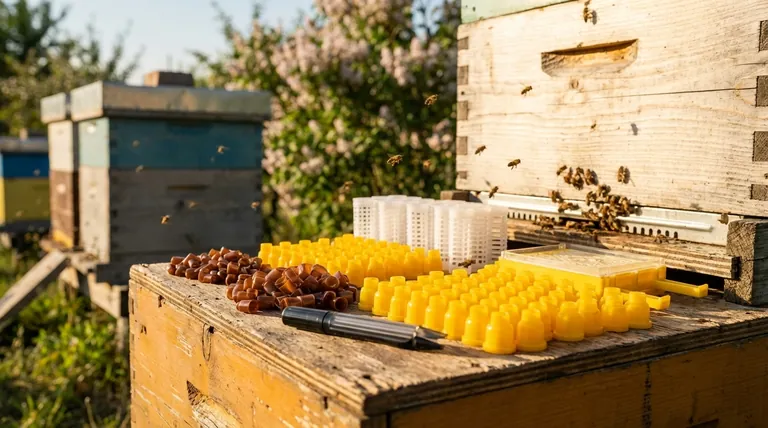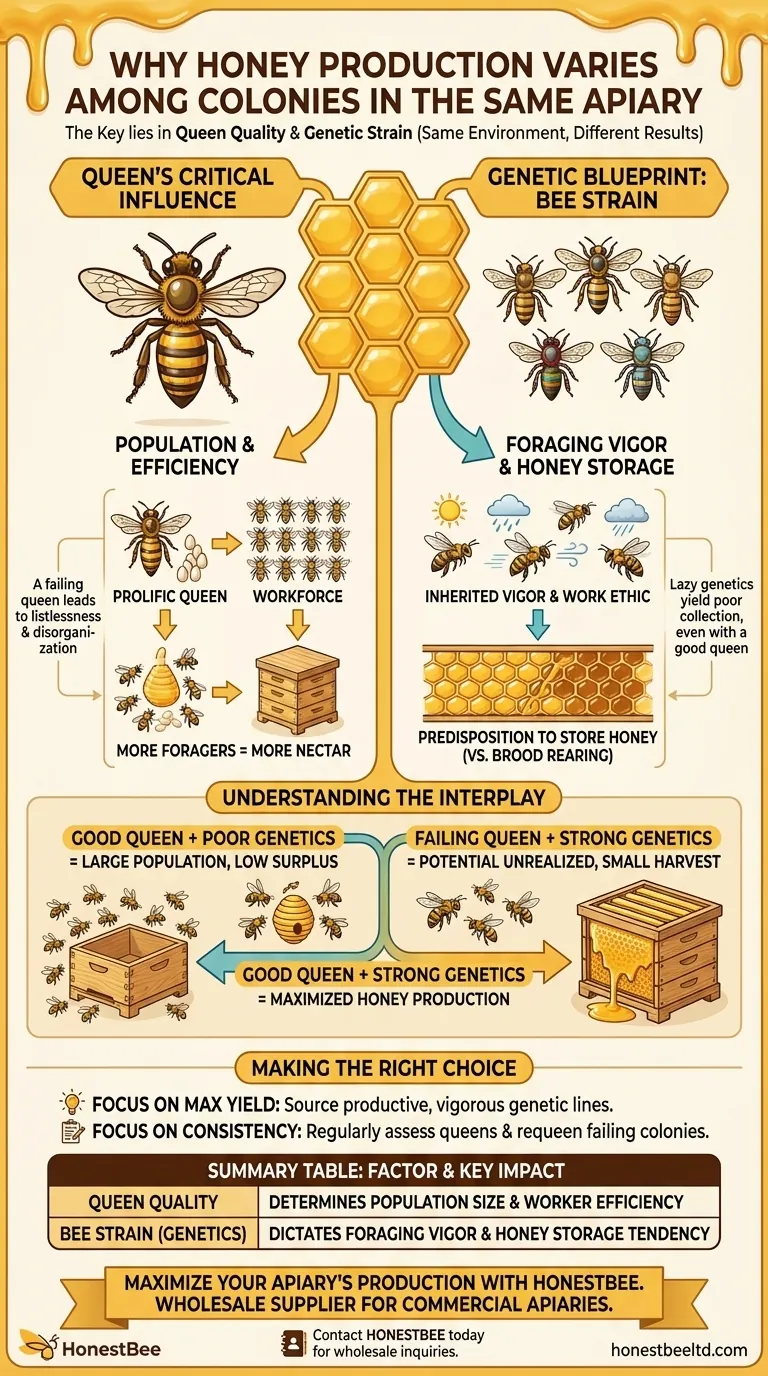The most significant factors causing differences in honey production among bee colonies, even within the same apiary, are the genetic strain of the bees and the quality of the queen in each colony. While external factors like nectar flow and weather are identical for all hives, these two internal variables dictate a colony's fundamental capacity for growth and productivity.
Even when facing the exact same environmental conditions, a colony's success is not guaranteed. The true bottleneck for honey production lies within the hive itself—determined by the queen's vitality and the workforce's genetic predispositions.

The Queen's Critical Influence on Production
The queen is the single most important individual in any colony. Her quality has a direct and cascading effect on the hive's population, morale, and, ultimately, its ability to produce a honey surplus.
A Queen's Link to Colony Population
A high-quality queen is, above all, a prolific egg-layer. A higher laying rate directly translates to a larger population of worker bees.
This is a simple numbers game: more workers create a larger foraging force. A larger foraging force can bring in significantly more nectar, leading to greater honey stores.
The Impact on Colony Efficiency
A strong, well-mated queen also ensures colony cohesion and organization through her pheromones. A colony with a failing queen can become listless, disorganized, and less motivated to work efficiently.
When the queen is performing well, the entire colony operates with a higher degree of purpose, from foraging to hive maintenance, maximizing their collective effort.
The Genetic Blueprint: Bee Strain
Beyond the individual queen, the underlying genetics of the entire colony play a pivotal role. The "strain" of the bee dictates the inherent traits and behaviors of the worker bees.
Inherited Foraging Vigor
Different strains of honey bees have different genetic tendencies. Some are naturally more vigorous and persistent foragers, while others may be more docile or less inclined to fly in marginal weather.
This inherited work ethic means two colonies side-by-side can have vastly different collection rates simply due to their genetic makeup.
Tendency to Store Honey
Genetics also influence how a colony allocates its resources. Some strains are predisposed to store nectar as honey at a faster rate.
Other strains might prioritize raising large amounts of brood, consuming incoming resources for population growth rather than storing it as a surplus. This trait directly impacts the amount of honey a beekeeper can harvest.
Understanding the Interplay of Factors
Neither queen quality nor genetic strain exists in a vacuum. The most productive colonies are those where both factors are strong, as one can easily limit the potential of the other.
A Good Queen with Poor Genetics
A beekeeper might have a young, prolific queen who lays thousands of eggs a day. However, if her genetic offspring are lazy foragers or are not predisposed to storing honey, the large population will fail to produce an impressive surplus.
Strong Genetics with a Failing Queen
Conversely, a colony could have excellent genetics known for high production. But if its queen is old, poorly mated, or failing, she cannot produce the sheer number of workers required to capitalize on that genetic potential. The colony will never reach the size needed for a large harvest.
Making the Right Choice for Your Apiary
Understanding these internal dynamics is the key to moving from a passive beekeeper to an active manager who can influence honey production.
- If your primary focus is maximizing honey yield: Actively source queens from breeders known for productive, vigorous genetic lines that are well-suited to your climate.
- If your primary focus is consistent performance: Regularly assess your queens for their brood pattern and overall colony health, and be prepared to requeen any colony that shows signs of decline.
Ultimately, a colony's potential is a direct reflection of its queen and its collective genetics.
Summary Table:
| Factor | Key Impact on Honey Production |
|---|---|
| Queen Quality | Determines colony population size and worker efficiency through egg-laying rate and pheromones. |
| Bee Strain (Genetics) | Dictates inherent foraging vigor, work ethic, and the colony's tendency to store honey. |
Maximize Your Apiary's Honey Production with HONESTBEE
Understanding the critical role of queen quality and genetics is the first step. The next is sourcing the right equipment and supplies to support your most productive colonies.
As a trusted wholesale supplier for commercial apiaries and beekeeping equipment distributors, HONESTBEE provides the durable, high-performance gear you need to manage your hives effectively. From hive components to protective clothing, our products are designed to help you capitalize on your investment in superior genetics and queen stock.
Ready to boost your harvest? Let's discuss how our supplies can support your operation's success.
Contact HONESTBEE today for wholesale inquiries
Visual Guide

Related Products
- Jenter Queen Rearing Kit Complete Set for Bee Breeding
- Nicot Queen Rearing Kit for Beekeeping and Grafting in Nicot System
- No Grafting Queen Rearing Kit: System for Royal Jelly Production and Queen Rearing
- HONESTBEE Premium Italian Style Hive Tool with Hardwood Handle
- HONESTBEE 15-in-1 Beekeeper Multi-Tool with Hammer and Pliers for Beekeeping
People Also Ask
- How long does it take for a new queen to emerge, mate, and lay eggs? A Beekeeper's 10-14 Day Guide
- What is the timeline for queen breeding? A 28-Day Guide from Egg to Laying Queen
- What is queen rearing in beekeeping? Take Control of Your Apiary's Genetics
- How can beekeepers start a honey bee breeding program? Build a Superior, Resilient Apiary
- What happens to the colony population during the 5–6 weeks after a new queen emerges? Understand the Natural Dip and Rebound



















